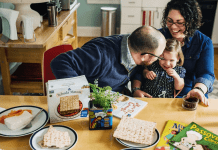My husband and I have walked into my late mother-in-law’s house for the last time.
We are in the process of settling her estate, including the sale of her house and disposition of everything in it.
From a hutch filled with china and crystal goblets to overflowing jewelry boxes and coin collections. And everything in between.
A lot in between.
Her clothes. The Notre Dame sweaters my late father-in-law was so fond of wearing. Her furniture. Furniture inherited from her mother-in-law, still in the same place in the garage where it was originally placed 30 some-odd years ago. My husband’s Cub Scout uniform. Christmas decorations. Lots and lots of Christmas decorations.
Every room, every closet, every shelf, every drawer. Full of stuff. A lifetime of stuff. Two lifetimes, if you count my father-in-law, who passed away 11 years ago.
What to Do With a Lifetime of Stuff
My mother-in-law was a neat and tidy housekeeper. But like many of us (myself included), she lived in a good-sized house with plenty of room to accommodate stuff. Things inherited from her parents and her in-laws. The broken vacuum cleaner waiting for repair in the back of the closet. Hundreds of books read once. You get the picture.
And the cost of disposing of all of that stuff? Having the estate sale company we hired go through every room, every closet, every drawer, separating the trash from the treasures, may cost more than will be generated at the eventual estate sale.
Her house has been transformed into a store, the estate sale company having cleverly arranged and displayed my mother-in-law’s possessions on tables in every room.
All of her possessions with any value, save the very few we kept, each with a tiny white price tag.
Losing your last surviving parent is hard enough. But being the arbiter of which of your parents’ and grandparents’ treasures get saved and which end up sold, donated, or in a landfill? gut-wrenching.
The lesson we have learned from this experience?
Most of the stuff in your house is worthless. And eventually, someone, either you or your kids, will be tasked with the overwhelming job of getting rid of it.
Most of Your Stuff Is Worthless
Most of the stuff in your house is worthless.
Yes, even the stuff you worry the most about, the stuff you think is so good you don’t use it for fear of breaking it, has little to no resale value.
From china, china cabinets, crystal goblets, silver tea sets, pianos, and collectible figurines like Hummels, to grandfather clocks and real pieces of craftsmanship furniture.
Why? Baby boomers have glutted the market with their castoffs, and millennials, the next generation of buyers, don’t want it.
Millennials hate both formal in-home entertaining and use of second-hand goods. With looming student loans, they tend to rent and move often. Who wants to be constantly moving a piano and a grandfather clock from apartment to apartment?
And furniture? There’s no market for so-called “brown furniture,” meaning any furniture (regardless of quality) other than the “mid-century casual” furniture (think clean, lightweight) favored by millennials. Brown furniture is basically firewood.
If it’s not in great condition, it’s also not fit for donation because it can’t be resold.
All of my mother-in-law’s furniture (including the pieces inherited from her mother-in-law and kept for decades)? Straight to the landfill.
Well, Almost Everything…
What do guns, LPs (records), and precious metals/gems have in common?
They are 3 things you might have in your house with a robust resale value.
Silverware also has value, but only if it is real silver and can be melted down.
3 Things You Should Be Doing NOW to Reduce the Amount of Stuff You Have
1. Be viciously thoughtful about holding onto sentimental items.
Here was our goal with sorting through my mother-in-law’s things. Keep just enough to remind us of her, but not so much stuff that our daughters are going to be dealing with it 40 some-odd years from now.
Here’s what we kept:
- A painting to be displayed in our dining room
- My mother-in-law’s treasured Swarovski crystal animal collection (all of which were given to her by her children and grandchildren over the years)
- Jewelry to be divided among the granddaughters
- Each of our daughters got to select 1 item
And that was it.
Well, almost. We did set aside photos to be digitized (with the originals then destroyed).
Was it hard leaving everything else? You bet it was. But we don’t want to be dealing with a lot of stuff years from now (or worse, leaving it to our daughters to deal with).
I try to be viciously thoughtful with my own sentimental items. For example, I don’t save any school papers or art projects from my kids (though I do take photos of my favorites).
2. Buy fewer books.
While used book resellers like Half Price Books do an important service in keeping books in circulation, a surprising number of books end up in landfills because many paper recycling facilities can’t process the the glue that binds book spines.
My resolution last year was to cut down on my book consumption by only reading books that I borrow from the library or purchase on my Kindle e-reader. If you haven’t used a library in years, now is the time to go back. My local library has an app where you can “order” books online, and pick them up the next day on a special “hold” shelf strategically placed next to the check-out kiosk.
How successful was I on my resolution? I read 1 to 2 books a week in 2019, only 1 of which was a hard copy purchased from Amazon.
3. Buy fewer, but better quality, clothes
The world is overflowing with used clothing.
We buy substantially more clothing over our lifetimes than our grandparents did.
Clothing made today is meant to last no more than a few years. In fact, a lot of clothing isn’t even made to withstand more than a few washes.
Think you are “paying it forward” but dropping off a load of unwanted clothes at Goodwill? Think again. Most clothing donations never make it to the racks at Goodwill and only about a third of what does eventually sells.
To really pay it forward, cut down on the amount of clothing you have by buying better quality clothes that last longer.
Keeping What Really Matters
My 5-year-old chose to keep a Christmas music box from her Grandma’s house. It plays “White Christmas” and has tiny ice skaters going around a rink inside. Each Christmas, my mother-in-law would bring out this music box and let each of her granddaughter’s play with it. It’s value in preserving a precious memory of Grandma? Priceless.














20 years from now:
Grandma: You look just like my old relatives, Johnny. Let’s look at these old photos of my great grandparents! Although we destroyed the original photo we digitized them onto this wonderful disk!
*inserts disk*
*disk unreadable*
Hahaha I was just thinking the same thing! I would never destroy original photos!! You never know what might happen to digital copies over the years! I even print out the best photos that I take with my digital camera or phone. I’m a millenial.
I have seen several articles on this topic that agree with your views, and, basically, I do, too. However, I have some further thoughts. I have noticed that members of the younger generations embrace thrift stores and companies that recycle or upcycle clothes and goods because these outlets are economical and good for the environment. Brown furniture can be painted for a more modern look, and what became of the stereotype that “old money” families shop in the attic? Is that not still true? Is that not still wise? Figurines are indeed problematic, but China (and even crystal) has a practical use. Yes, they don’t belong in the dishwasher, but not all apartments and homes even have dishwashers, especially when one is starting out in adult life. It’s safe to assume that you’re not going to get a lot of cash for these items, but they’re certainly not worthless as long as they can still be used and enjoyed by someone. And who knows? If the new owner takes care of them, they may find that their market value returns when all that is old becomes new and fashionable again. I won’t force on my children what I have inherited, but I will wholeheartedly encourage them to take and use what they can regardless of whether it is trendy at the time. These quality products will save them money and connect them to their history.
All true, but saying that 2/3 of the stuff don’t make it into Goodwill is false. The dumpsters are not that big. And did you ever count the Thrift Stores….. There are just about now as many as there are churches. There are sensible people recycling all the “junk” you threw in the landfill. There are sensible people Buying the “new” treasures in these stores for a good price. The saying someone else’s junk is someone else’s treasure is true. Lol, when I am dead and can’t sort through my stuff, I would not care anymore. I hope my kids find the odd treasure…. I know i raised them well, they will deal with it and recycle all my recycled stuff again helping the land fills a third time. My mission executed and completed all while I enjoyed my “junked treasures” Have a super day.
As a millennial, it’s not that I hate in home entertaining, I just don’t need a completely different set of plates, cutlery, and serving ware to do it.
if the possessions make the folks happy then that is great.
The keepsakes are exactly that.
it is their remembrances of their lives.
I see no problem with that.
If the ungrateful offspring are so burdened with settling the estate then they have forgotten all the things their parents went through to raise them.
so what do you do start throwing out moms possessions while she is sitting there watching?
The stuff is worthless to you not necessarily to them.
lighten up.
Don’t take control over your parents lives too soon.
The parents need your love not your unwelcome control.
I tried to do that and the Estate salespeople ended up robbing me and I filed a police report and they said I would have to take them to small claims court. This is beyond upsetting and I can’t even file theft with my insurance co. cause my rates would go up and I would lose $1,000.00 right off the bat!
Having just moved from a house we called home for 36 years, I could agree more. I had to tell myself that we got joy from certain things and let it go. Very hard to do if you are sentimental like I am! Great advice, thanks.
This was the best article I have read in a long time about decluttering. I have been trying to declutter in stages for years, because I don’t want my only son to have to go through the things and say why did mom keep this…
Please post more about this topic because it definitely is something we need to pay attention to.
I am going to let my family go thu my stuff, because I would not know what was important to them. I would hope that they would appreciate great- grandmothers rocking chair, dresser and great grandfathers cup,, pocket watch, etc. I would never destroy old photos,. I do genealogy,and would love to have more old photos of my family,if you do not want them scan and put on ancestry, so others looking for them might find them. young folks will find out new furniture will have to be replaced every few years because it is not made to last and it will add to the landfill.
So brutal but true. I am going through this now. I have things dating back to the late 1800s, family items. Items from great grandparents, great aunts, uncles, parents, deceased sister, brother, and so forth. It is amazing how much we do amass. I am only keeping items that have family value, giving children and grandchildren items that they have shown interest in keeping or having that is. Also, some items do have a value, so checking on those, and then sell. Mostly donating items to various applicable places. Senior centers like puzzles and books, hospitals take books, nursing homes take books and magazines. Craft items are difficult to get rid of so I donate to places like Goodwill. Some clothing and ladies accessories to Vintage clothing stores. It takes work to keep things out of the trash. As I go through belongs I have boxes designated for trash, recycle, donation, and for paperwork that I do not file immediately, a box for shredding. We do not have to get rid of it all, and we are allowed to keep items that we like to look at, or use daily instead of waiting for special occasions. It is a process. As we go through those items, we have those memories to keep. Pictures and jewelry are other projects within themselves.